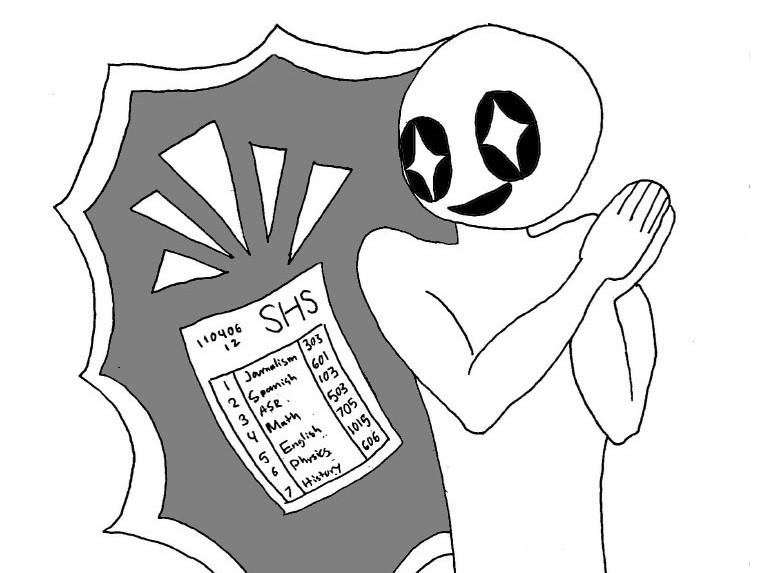For many students, the option of taking six or fewer classes a year is a godsend: It could mean waking up hours later than normal, leaving school right after lunch or even skipping mosaics and rallies during tutorials. However, an often overlooked aspect of selecting courses are the numerous benefits associated with taking seven classes (yes, even as upperclassmen).
The choice of what to do with seventh period is always a tough one, whether students choose a free period to complete assignments or take another homework-intensive class.
As seniors who have taken seven classes for the past three years, we have found that taking seven classes is worth the extra time and effort.
With a set number of mandatory classes each year — five in freshman year, four in sophomore and junior year and two in senior year — students aren’t left with many choices for electives. For those choosing to participate in a “series” of courses all four years, such as languages, art, drama, journalism or music, students may be left with only one or two truly free electives.
After dipping their toes into a course to fulfill a graduation requirement, students might find a new genuine interest blooming in one of those courses. The seventh period becomes the perfect opportunity to continue this interest, turning it into something to continue long after graduation.
More courses supplement and support new interests
Language courses such as Chinese or Spanish instantly come to mind, especially since they are needed for graduation. Although the first few years of a language are focused on grammatical rules, advanced level classes delve deeper into each respective language’s culture and the traditions celebrated by countries speaking that language. While many choose to only take language for one or two years, taking it for all four can be beneficial: By opting not to take the advanced levels of these courses, students miss out on solidifying their skills and cultural appreciation.
Bai’s experience: I found an interest in learning the cultures of Spain and Peru and plan on continuing learning Spanish into college. Learning a new language will help me in the future, improving communication with a wider range of people without the use of a translator and allowing me to watch foreign movies without subtitles.
Students should also consider taking an elective that allows them to supplement an extracurricular outside of school.
Dai’s experience: Having taken art classes outside of school since age 6, I found the addition of taking art courses at the school exposed me to a community I wouldn’t otherwise have joined. Art 2, Art 3 and AP Drawing allowed me to explore different mediums and styles of art. Occasional check-ins, where the teacher and other classmates would comment and give advice on each other’s work, were also an incredibly helpful resource that exposed me to different perspectives.
That’s not to say, however, that students cannot join one of these “series” of courses if they don’t partake in them freshman year. Many classes offer a smooth integration into the course material. Student-led classes such as newspaper often see an influx of juniors joining the elective, who then continue as an editor during their senior year.
Take advantage of rare, limited-time courses
In other instances, sacrificing one course — by postponing it by a year to make room for a course this year — is necessary.
Dai: During the 2022-2023 school year, I took the Advanced Science Research (ASR) course offered at Los Gatos High School, which helped me develop laboratory and project design skills for research. Choosing to take ASR in my junior year proved to be a lucky choice: The course was discontinued in June as teachers felt “overwhelmed by the large enrollment that year.”
With the school population fluctuating, the electives offered each year are different, and it’s uncertain whether a course offered this year will be available next year. Therefore, if students see a course they’re interested in, they should take advantage of them — these opportunities are worth sacrificing a free period for, especially since the course might not be offered forever with dwindling school size and resources annually.
Develop connections with other students through communities
Bottom line: Through taking courses such as journalism, we have come to appreciate the community they’ve become a part of as well. For those taking multiple “series” courses, taking seven classes a year is often inevitable.
High school is a time to form bonds with other students; this should be enough of a selling point to consider spending seventh period joining one of these student-run courses. The value of making friends from different grades and communities can not be understated. Talking with seniors regarding difficult courses or learning more about a specific sport by talking with another classmate are invaluable parts of the high school experience.
Bai: Many of these classes also provide opportunities for leadership roles. Through being an editor on the school newspaper, I have found significant improvement through my ability to manage time and assist younger staff members. Through the presentation of story ideas in information discussions my co-editor and I lead, I have also greatly improved my presentation skills.
Through interviewing sources, I have been able to think faster on the spot, thinking of follow-up questions to learn more about a specific topic. This has helped me greatly through my other time commitments such as the school’s TEDx club, where I had to reach out to speakers, and difficult classes such as Physics C where I use my improved ability in asking questions to learn more about conceptual ideas.
Ultimately, the decision to take a seventh class should only be made once the benefits and costs are scrutinized. Despite our increased workload, heavy stress and potentially later bedtimes, we don’t regret taking seven classes each year for our past three years. The memories, skills and experiences we’ve gained from each additional elective will last us a lifetime.


























